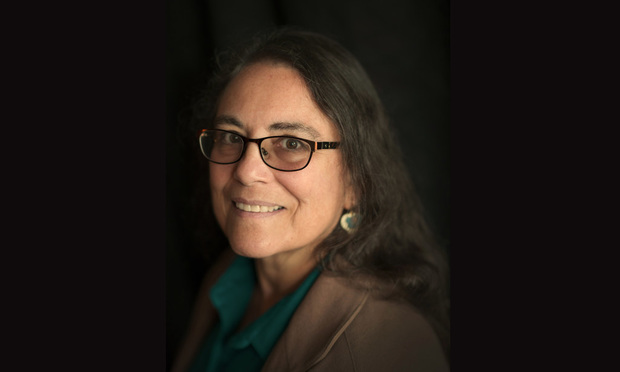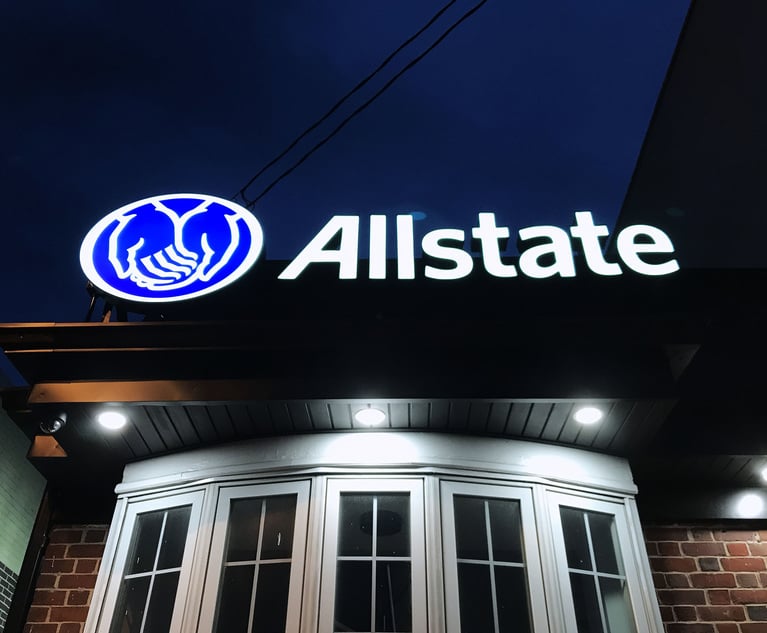On Appeals: California Supreme Court's Latest Guidance on How to Answer 'Who's Appealing?'
In 'K.J. v. Los Angeles Unified School District,' the court offered some clarification as to how far one can stretch the maxim that notices of appeal are to be liberally construed.
February 12, 2020 at 10:30 AM
5 minute read
 Sarah Hofstadter of California Appellate Law Group.
Sarah Hofstadter of California Appellate Law Group.
Most appellate lawyers know the maxim that notices of appeal are to be liberally construed. Indeed, it is codified in rule 8.100(a)(2) of the California Rules of Court. But how far does that liberal construction stretch?
In a recent opinion, K.J. v. Los Angeles Unified School District, the California Supreme Court offered some clarification on this point. Reversing a Court of Appeal's dismissal of an appeal, the Supreme Court held that under some circumstances, an appeal can proceed on the merits despite the failure of the notice of appeal to identify the correct appellant.
In K.J., a student sued her school district for negligence in connection with a sexual assault she suffered on school grounds. During pretrial proceedings, the trial court issued an appealable order awarding substantial discovery sanctions against one of the student's lawyers, but not the student herself. A notice of appeal was timely filed, but it stated that the student was appealing from the discovery sanctions order, and included no reference to the sanctioned lawyer.
In the Court of Appeal, the school district argued in its respondent's brief that the appeal should be dismissed because the student lacked standing to appeal an order imposing discovery sanctions only on her counsel. In reply, the attorney argued that the notice of appeal should be liberally construed to include him as an appellant. The Court of Appeal dismissed the case, holding that a notice of appeal cannot be construed to include a person not named in the notice as an appellant.
The Supreme Court unanimously reversed, based on the public policy interests underlying the liberal construction requirement. If it is reasonably clear from the record that the opposing party understood who was actually pursuing the appeal, and was not confused or prejudiced, the court held the appellant should not forfeit the right to appeal due to the omission of his or her name from the notice of appeal.
In K.J., the attorney's intent to appeal was clear, because only the sanctions order was appealed; the attorney had vigorously contested the order in the trial court; and the attorney was the only person adversely affected by the order. Moreover, the school district had not argued it was prejudiced by the inaccuracy in the notice of appeal. Indeed, the record did not reflect any such prejudice, as the school district had already briefed the merits of the appeal. The fact that a broad construction of the notice of appeal would permit the appeal to go forward on the merits, possibly resulting in a reversal, was not "a cognizable form of 'prejudice'" warranting dismissal.
The Supreme Court noted, however, that there are limitations on when such a broad construction is justified. If a particular party's intent to join in the appeal is not clear from the record or the opposing party is prejudiced by the omission, the notice of appeal will not be construed to include the omitted party. Thus, the court stressed that the better practice when an attorney appeals a sanctions order "is for the attorney to file a notice of appeal that expressly identifies himself or herself as an appealing party."
The K.J. opinion offers guidance to trial and appellate lawyers on two points. First, when filing a notice of appeal, be sure you have correctly identified not only all of the judgments or orders from which the appeal is taken, but also all of the appellants. K.J. construed a notice of appeal to include as an appellant a person not named in the notice, but it did so under a very specific set of circumstances. Under other circumstances—particularly if there is prejudice to the opposing party—you cannot count on an appellate court to be so generous. A notice of appeal is a simple document, but you still need to review it carefully to make sure all the parties who want to appeal are named in the notice.
Second, when your opposing party in a case files a notice of appeal that appears to be defective, it's best to raise the issue by motion to dismiss, before you and your client invest time and money in briefing the appeal on the merits. In K.J., the Supreme Court held the school district had not been prejudiced by the error, in part because it did not raise the issue until it filed its respondent's brief. Had the school district raised the issue in a motion to dismiss, before briefing, that prejudice assessment might have gone the other way. More broadly, in any appeal in which a dismissal is reasonably likely, early action on the part of respondent's counsel in the form of a motion to dismiss can save time and money for the client—and the Court of Appeal.
On Appeals is a monthly column by the attorneys of the California Appellate Law Group LLP, an appellate boutique with offices in San Francisco and Los Angeles. Sarah Hofstadter is of counsel with the firm and has spent more than a dozen years as a research and staff attorney for jurists on the California Courts of Appeal and the Ninth Circuit. Find out more about Sarah and the California Appellate Law Group LLP at www.calapplaw.com.
This content has been archived. It is available through our partners, LexisNexis® and Bloomberg Law.
To view this content, please continue to their sites.
Not a Lexis Subscriber?
Subscribe Now
Not a Bloomberg Law Subscriber?
Subscribe Now
NOT FOR REPRINT
© 2025 ALM Global, LLC, All Rights Reserved. Request academic re-use from www.copyright.com. All other uses, submit a request to [email protected]. For more information visit Asset & Logo Licensing.
You Might Like
View All
State Appeals Court Revives BraunHagey Lawsuit Alleging $4.2M Unlawful Wire to China
3 minute read

Apple Disputes 'Efforts to Manufacture' Imaging Sensor Claims Against iPhone 15 Technology

Lawsuit alleges racial and gender discrimination led to an Air Force contractor's death at California airfield
7 minute readTrending Stories
- 1Learning From Experience: The Best and Worst of Years Past
- 2Treasury GC Returns to Davis Polk to Co-Chair White-Collar Defense and Investigations Practice
- 3Decision of the Day: JFK to Paris Stowaway's Bail Revocation Explained
- 4Doug Emhoff, Husband of Former VP Harris, Lands at Willkie
- 5LexisNexis Announces Public Availability of Personalized AI Assistant Protégé
Who Got The Work
J. Brugh Lower of Gibbons has entered an appearance for industrial equipment supplier Devco Corporation in a pending trademark infringement lawsuit. The suit, accusing the defendant of selling knock-off Graco products, was filed Dec. 18 in New Jersey District Court by Rivkin Radler on behalf of Graco Inc. and Graco Minnesota. The case, assigned to U.S. District Judge Zahid N. Quraishi, is 3:24-cv-11294, Graco Inc. et al v. Devco Corporation.
Who Got The Work
Rebecca Maller-Stein and Kent A. Yalowitz of Arnold & Porter Kaye Scholer have entered their appearances for Hanaco Venture Capital and its executives, Lior Prosor and David Frankel, in a pending securities lawsuit. The action, filed on Dec. 24 in New York Southern District Court by Zell, Aron & Co. on behalf of Goldeneye Advisors, accuses the defendants of negligently and fraudulently managing the plaintiff's $1 million investment. The case, assigned to U.S. District Judge Vernon S. Broderick, is 1:24-cv-09918, Goldeneye Advisors, LLC v. Hanaco Venture Capital, Ltd. et al.
Who Got The Work
Attorneys from A&O Shearman has stepped in as defense counsel for Toronto-Dominion Bank and other defendants in a pending securities class action. The suit, filed Dec. 11 in New York Southern District Court by Bleichmar Fonti & Auld, accuses the defendants of concealing the bank's 'pervasive' deficiencies in regards to its compliance with the Bank Secrecy Act and the quality of its anti-money laundering controls. The case, assigned to U.S. District Judge Arun Subramanian, is 1:24-cv-09445, Gonzalez v. The Toronto-Dominion Bank et al.
Who Got The Work
Crown Castle International, a Pennsylvania company providing shared communications infrastructure, has turned to Luke D. Wolf of Gordon Rees Scully Mansukhani to fend off a pending breach-of-contract lawsuit. The court action, filed Nov. 25 in Michigan Eastern District Court by Hooper Hathaway PC on behalf of The Town Residences LLC, accuses Crown Castle of failing to transfer approximately $30,000 in utility payments from T-Mobile in breach of a roof-top lease and assignment agreement. The case, assigned to U.S. District Judge Susan K. Declercq, is 2:24-cv-13131, The Town Residences LLC v. T-Mobile US, Inc. et al.
Who Got The Work
Wilfred P. Coronato and Daniel M. Schwartz of McCarter & English have stepped in as defense counsel to Electrolux Home Products Inc. in a pending product liability lawsuit. The court action, filed Nov. 26 in New York Eastern District Court by Poulos Lopiccolo PC and Nagel Rice LLP on behalf of David Stern, alleges that the defendant's refrigerators’ drawers and shelving repeatedly break and fall apart within months after purchase. The case, assigned to U.S. District Judge Joan M. Azrack, is 2:24-cv-08204, Stern v. Electrolux Home Products, Inc.
Featured Firms
Law Offices of Gary Martin Hays & Associates, P.C.
(470) 294-1674
Law Offices of Mark E. Salomone
(857) 444-6468
Smith & Hassler
(713) 739-1250






